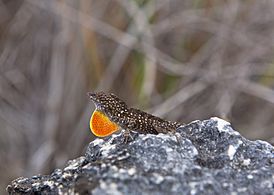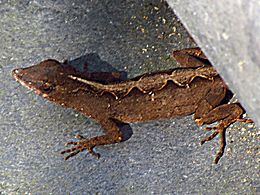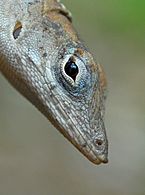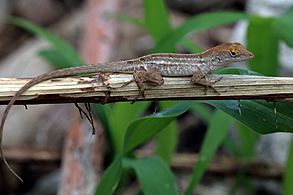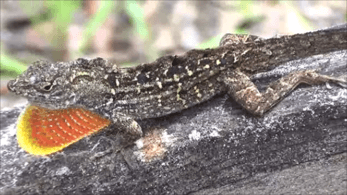Brown anole facts for kids
Quick facts for kids Brown anole |
|
|---|---|
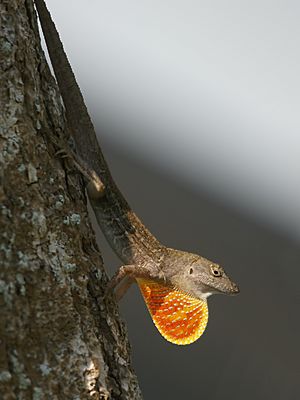 |
|
| Male displaying dewlap | |
| Conservation status | |
| Scientific classification | |
| Genus: |
Anolis
|
| Species: |
sagrei
|
| Synonyms | |
|
|
The brown anole (Anolis sagrei) is a type of lizard. It is also called the Bahaman anole or De la Sagra's anole. These lizards originally come from Cuba and the Bahamas.
Brown anoles have been moved to many other places around the world. People often sell them as pets. Now, you can find them in Florida and other parts of the United States. This includes southern Georgia, Texas, Louisiana, Mississippi, Alabama, Hawaii, and Southern California. They have also spread to other Caribbean islands and even Taiwan in Asia.
This lizard is known for being very invasive. This means it can spread quickly and take over new areas. Where it has been introduced, many brown anoles can live together. They can also outcompete and sometimes eat other native lizards. For example, when brown anoles came to the United States in the 1970s, they changed how the native Carolina anole (also called the green anole) behaves. Green anoles now mostly stay in the treetops to avoid the brown anoles.
Contents
What's in a Name?
The scientific name for the brown anole is sagrei. This name honors a Spanish botanist named Ramón de la Sagra.
Brown Anole Appearance
Brown anoles are usually light brown. They have darker brown or black marks on their backs. You might also see several tan or light-colored lines on their sides. Like other anoles, they can change their color. They can turn a darker brown or even black.
The male brown anole has a special flap of skin under its throat called a dewlap. This dewlap can be yellow to orange-red. Male brown anoles can grow to be about 17.8 to 20.3 centimeters (7 to 8 inches) long. Some can even reach up to 22.9 centimeters (9 inches). Female brown anoles are smaller, usually 7.6 to 15 centimeters (3 to 6 inches) long.
The male brown anole's head is smaller than that of the male Carolina anole. Brown anoles also have a ridge on their tail that goes all the way up behind their head. Carolina anoles do not have this ridge. Female brown anoles often have a light brown stripe running down their back. Males do not have this stripe.
-
Florida female
-
Grand Cayman juvenile
-
Male extending his dewlap in Citrus County, Florida
Brown Anole Life Cycle
In the wild, brown anoles usually live for about 4 to 5 years. However, some have lived up to 8 years when kept as pets. They become old enough to have babies one year after they hatch. They usually breed during the summer months. This is typically from March or April to August or September.
After breeding, the female lays 1 to 2 eggs every 7 to 14 days. She buries the eggs and then leaves them. If the eggs are healthy, they will hatch about seven weeks later. The baby anoles that survive do so completely by instinct.
Shedding Skin
Brown anoles shed their skin in small pieces. This is different from some other reptiles that shed their skin all at once. Anoles might eat their old skin. This helps them get back important minerals like calcium.
If a pet anole's home is not humid enough, the old skin might stick to it. This unshed skin can build up around the eyes. If this happens, the lizard might not be able to see to eat. This can lead to it becoming very hungry. Keeping the air moist where they live can prevent this.
What Brown Anoles Eat
Brown anoles eat small arthropods. These include crickets, moths, ants, grasshoppers, cockroaches, mealworms, spiders, and waxworms. They might also eat other lizards, like skinks and the Carolina anole. They can also eat lizard eggs. Sometimes, they even eat their own shed skin or tails that have broken off. If they are near water, they will eat water insects or small fish. They will eat almost anything that fits into their mouths.
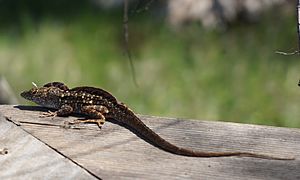
How Brown Anoles Protect Themselves
As a way to protect themselves, brown anoles can break off most of their tail. This happens if a predator chases or catches them. The piece of tail that breaks off will keep moving. This can distract the predator, giving the anole a chance to escape. The lost tail will grow back partially.
If a brown anole feels threatened, it might bite, urinate, or poop. Some brown anoles may also make a short hiss if they are caught, hurt, or fighting. Animals that hunt brown anoles include rats, snakes, birds, and many larger animals like cats.
How Brown Anoles Communicate
Anoles mostly use visual signals to communicate. This means they use things they can see, like body movements or changing their dewlap.
See also
 In Spanish: Abaniquillo pardo para niños
In Spanish: Abaniquillo pardo para niños



